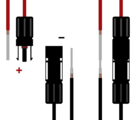Difference between revisions of "Installing module connectors"
Jump to navigation
Jump to search
(Marked this version for translation) |
|||
| (2 intermediate revisions by the same user not shown) | |||
| Line 1: | Line 1: | ||
[[Category:System installation]] | [[Category:System installation]] | ||
| + | <languages /> | ||
| + | <translate> | ||
| − | All [[Module connectors|PV module connectors]] are designed to be easily snapped together, but to require a tool to disconnect the connection once made. The steps for installing an MC4 connector on a wire are as follows: | + | <!--T:1--> |
| + | All [[Special:MyLanguage/Module connectors|PV module connectors]] are designed to be easily snapped together, but to require a tool to disconnect the connection once made. The steps for installing an MC4 connector on a wire are as follows: | ||
#Ensure that the connector is the right connector type. | #Ensure that the connector is the right connector type. | ||
#Ensure that the connector is the right size for the wire. | #Ensure that the connector is the right size for the wire. | ||
| − | #Ensure that the connector is the proper [[ | + | #Ensure that the connector is the proper [[Special:MyLanguage/Electricity types|polarity]] for the connection. Positive plastic MC4 connectors (male) insert into negative plastic MC4 connectors (female). |
#For each MC4 connector there is a metallic connector that must be crimped onto the wire before it is inserted into the plastic body of the connector. Inside the positive plastic MC4 connector (male) there is a female metallic part. Inside the negative plastic MC4 connector (female) there is a male metallic part. | #For each MC4 connector there is a metallic connector that must be crimped onto the wire before it is inserted into the plastic body of the connector. Inside the positive plastic MC4 connector (male) there is a female metallic part. Inside the negative plastic MC4 connector (female) there is a male metallic part. | ||
#Strip back the wire enough to fit into the crimped section of the metallic connector. | #Strip back the wire enough to fit into the crimped section of the metallic connector. | ||
| Line 12: | Line 15: | ||
#Tighten the bushing on the back of the connector to ensure that it is water-tight using the plastic MC4 tools. | #Tighten the bushing on the back of the connector to ensure that it is water-tight using the plastic MC4 tools. | ||
| + | <!--T:2--> | ||
<gallery widths=250px> | <gallery widths=250px> | ||
File:Mc4connector.png|Positive and negative MC4 connectors with inside metal parts. The wires have not been crimped in the graphic. | File:Mc4connector.png|Positive and negative MC4 connectors with inside metal parts. The wires have not been crimped in the graphic. | ||
File:Mc4tools201106.png|'''(1)''' Plastic tool for disconnecting and tightening MC4 connectors. '''(2)''' MC4 crimper with various different crimping dies. | File:Mc4tools201106.png|'''(1)''' Plastic tool for disconnecting and tightening MC4 connectors. '''(2)''' MC4 crimper with various different crimping dies. | ||
</gallery> | </gallery> | ||
| + | |||
| + | ==Notes/references== <!--T:3--> | ||
| + | </translate> | ||
Latest revision as of 18:21, 7 March 2021
All PV module connectors are designed to be easily snapped together, but to require a tool to disconnect the connection once made. The steps for installing an MC4 connector on a wire are as follows:
- Ensure that the connector is the right connector type.
- Ensure that the connector is the right size for the wire.
- Ensure that the connector is the proper polarity for the connection. Positive plastic MC4 connectors (male) insert into negative plastic MC4 connectors (female).
- For each MC4 connector there is a metallic connector that must be crimped onto the wire before it is inserted into the plastic body of the connector. Inside the positive plastic MC4 connector (male) there is a female metallic part. Inside the negative plastic MC4 connector (female) there is a male metallic part.
- Strip back the wire enough to fit into the crimped section of the metallic connector.
- MC4 crimpers have different size crimping dies, select the appropriate size for the wire.
- Crimp the metallic connector around the wire.
- Insert the wire and connector into the plastic body of the correct MC4 connector.
- Tighten the bushing on the back of the connector to ensure that it is water-tight using the plastic MC4 tools.

